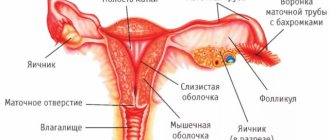Every month, changes occur in the body of a reproductively healthy sexually mature woman, ending with menstruation. Any changes in the nature of menstrual bleeding puzzle a woman and become a cause for concern. Clots or pieces of menstrual blood can be either normal or a signal of serious pathologies that require immediate treatment.
Natural causes of clots
During the onset of the cycle, dark lumps are released from the woman’s body along with liquid blood. This is due to the fact that a healthy body prepares for subsequent pregnancy once a month. It produces a large amount of substances that promote the growth and strengthening of uterine tissue, for the attachment of a fertilized egg to it.
If pregnancy does not occur, the layer of tissue peels off and then during menstruation large clots come out along with blood. Typically, this is liquid discharge with thickenings not exceeding 0.5 cm.
Minor pain during this period, minor discomfort, mood swings, low blood pressure and increased fatigue are a normal course of the menstrual cycle, due to hormonal surges. When during menstruation blood clots look like jelly, but are not accompanied by severe pain and heavy discharge, then they are not signs of diseases or other pathologies. Lumps in the form of jelly can be an individual feature, caused by diet and lifestyle.
If large pieces of uterine tissue come out during menstruation, as shown in the photo, this may indicate congestion in the uterine cavity. The absence of other symptoms means there is no cause for concern. The cause of heavy periods with blood clots, which are accompanied by severe discomfort, should be sought with a gynecologist.
At a young age
The formation of regular periods in adolescents takes up to three years. During it, the norm is irregularity of the cycle, abundance or scarcity of the total amount of discharge, the appearance of menstruation with pieces of tissue, after a previous delay. The reasons may be the girl’s rapid growth, hormonal changes, and stressful conditions in the body characteristic of adolescence. These phenomena usually go away after menstruation begins, without consulting a doctor.
During the reproductive period
After regular periods are established, large blood clots during menstruation may be released for physiological reasons:
- Increased physical activity, heavy lifting before or during menstruation.
- Visiting a bathhouse or sauna, staying on the beach for a long time at high temperatures the day before or during the cycle.
- Constantly sedentary lifestyle, causing blood stagnation.
- Too intense sex life.
- Individual characteristics (curvature of the uterus).
Such cases are not frequent, they pass with the end of the cycle, the following regulations will remain unchanged.
OK
Taking oral contraceptives (pills) can cause such discharge if an individual reacts to certain medications. Usually everything returns to normal when you change contraceptives.
Intrauterine contraception
Incorrect position is often provoked by the proliferation of uterine tissue, polyposis, severe and prolonged bleeding with clots. The intrauterine device itself is a means of terminating pregnancy, not preventing it.
The contraceptive prevents the fertilized egg from attaching to the wall of the uterus. A miscarriage is excreted from the body along with blood in the form of clots. The body perceives the spiral as a foreign object and seeks to get rid of it with the help of copious secretions, partly in the form of lumps.
Abortion
Abortion intervention - after curettage of the fetus, if a lot of blood clots come out during monthly bleeding similar to the liver - this is the norm. If there are no other complaints, then you do not need to contact a gynecologist.
Childbirth
Such bleeding can be a consequence of natural childbirth or cesarean section; there will be huge clots and lumps of blood during menstruation similar to the liver. Their size can be up to 12 cm. The process of restoration of the uterus lasts 7–10 days, the woman in labor is under constant medical supervision, so she receives the necessary help as needed.
During my period, some kind of film came out
Of course I'm exaggerating about the meat. Some kind of film about 2 cm in size comes out. Is this an egg or a miscarriage? Sometimes I don't notice it, and sometimes it stays on the gasket. What is this?
Woman.ru experts
Find out the opinion of an expert on your topic
Semikolennykh Nadezhda Vladimirovna
Psychologist. Specialist from the site b17.ru
Veronica Viktorovna Dobroselskaya
Psychologist, Weight correction. Specialist from the site b17.ru
Wrzecinska Eva
Psychologist. Specialist from the site b17.ru
Antakova Lyubov Nikolaevna
Psychologist, Consultant. Specialist from the site b17.ru
Tiselskaya Ekaterina Vladimirovna
Psychologist. Specialist from the site b17.ru
Korotina Svetlana Yurievna
Psychotherapist. Specialist from the site b17.ru
Nekrasova Natalia
Psychologist. Specialist from the site b17.ru
Anastasia Sergeevna Shikhaleeva
Psychologist. Specialist from the site b17.ru
Volkov Roman Leonidovich
Psychologist, Psychoanalytic therapist. Specialist from the site b17.ru
Sokol Larisa Ivanovna
Psychologist, Gestalt therapist. Specialist from the site b17.ru
this is a piece of endometrium
yeah, author... did you just start your period yesterday?)))))
what miscarriage? I mean, do you have periods during pregnancy?
This is the endometrium, which grows at the beginning of menstruation and is rejected every month under the influence of hormones. The endometrium is rejected in the form of clots, the vessels at the site of its separation are exposed and bleed - this is the so-called. "period". You cannot see the egg with the naked eye, no matter how hard you try.
this is a piece of endometrium
Do you think you have a miscarriage once a month? you know better, of course, if there are prerequisites, be careful, protect yourself, you can’t get rid of a real pregnancy so easily and spontaneously, keep in mind I really can’t
Her period has just started, and there is already so much traffic that she expects miscarriages every month. well, what about the youth?
This is the endometrium. Nutritious “soil” for the fertilized egg, which covers the inner surface of the uterus during ovulation.
If the egg is not fertilized, then this “soil” is rejected by the uterus and comes out in the form of bleeding. In the next cycle the process is repeated. Your “piece of meat” is simply the largest endometrial clot.
The egg itself is transparent and insignificantly small for you to notice it.
and doctors say that women have a lot of undetected miscarriages
It happens if, for example, the egg was unable to attach. The cause may be a polyp
Gostnet, nevermind! It’s the author’s liver falling out. ahahahaa ))))))))))))
this is the endometrium that grows during the cycle, in which, in theory, the fetus should lie if you became pregnant
endometrium
Source: https://zodiacc.ru/info/vo-vremja-mesjachnyh-vyshla-kakaja-to-plenka/
Pathological causes
Often, discharge with clots during menstruation is a sign of disorders:
Congenital or acquired pathological changes in the cervix
Sometimes they are formed in the embryonic stage; they can be a consequence of abortion, stressful conditions, or the presence of bad habits.
Infectious or sexually transmitted diseases
Sexually transmitted diseases are often painless and asymptomatic. It is necessary to examine both partners at the slightest suspicion, even if the tests of one showed the absence of infection, since the disease can occur even with negative tests.
Hormonal disorders
When there is an imbalance of hormones during menstruation, large dark blood clots similar to the liver come out. The hormones produced by the body accelerate the growth of the uterine lining, increase its quantity, and increase the duration and volume of discharge.
Discharge with a similar problem darkens to brown. The reasons why periods are brown and hormone imbalance can be endocrine diseases, taking hormonal medications, unbalanced nutrition during diets (lack of fat in the diet), and age-related changes.
Endometrium, fibroids, adenomyosis
These are common diseases in women of reproductive age. They are characterized by strong discharge, during which the mucous layer comes out during menstruation, in the form of large lumps similar to the liver. Urgent treatment or, if indicated, surgery is necessary.
Complication during pregnancy
Large blood clots similar to the liver are a threat of miscarriage or miscarriage in the early stages of gestation (in the first month after conception) . In such cases, heavy discharge is accompanied by severe cramping pain, nausea, and symptoms of a drop in blood pressure. Much less often, such symptoms may indicate an ectopic pregnancy.
Removal of the plug before childbirth
A woman may observe discharge in the form of white clots during pregnancy shortly before giving birth. This is the norm when the pregnancy is full-term and the baby is ready to meet the outside world.
During the removal of the plug, a representative of the fair sex may detect one large clot or several small ones. The plug can come out either at once or in parts over one or two weeks. The large volume of released substance should not be scary. Normally, you can detect up to two tablespoons of such discharge.
Discharge with clots like liver during menopause
Natural bleeding during menopause is due to age-related reasons - they are associated with hormonal changes in the whole body, the decline of reproductive function (childbearing period), and are a transition to the elderly phase.
Pathological changes accompanied by excessive bleeding with clots occur for various reasons:
- Use of contraceptives.
- Menopausal changes that are not characteristic of real age. May begin at the age of 30–34 years. The reason may be early menstruation, absence of pregnancies or a long gap between births, diseases of the reproductive organs, abortion, or refusal of breastfeeding. Lately they are becoming more common.
- Hereditary factors.
- Complications after infectious diseases and surgical interventions.
- Age-related changes in blood clotting, tendency to blood clots. As a result, a lot of blood accumulates in the uterine cavity and clumping occurs.
- Constant use of medications for chronic diseases (endocrine system, diabetes) that affect the overall hormonal balance of the body.
- Inflammatory processes and tumor-like pathologies in the lower spine, genitourinary system, and intestines.
Hormonal disorders
As you know, in the second phase of the cycle, a woman may experience creamy white discharge. They are normal and do not require treatment. However, in some cases, such cervical mucus is not cyclical, but is constantly present. What could be causing this?
Most likely, the woman has a hormonal imbalance. In this case, such discharge is accompanied by an irregular cycle, fatigue, irritability, and poor health. In this case, it is necessary to visit a qualified specialist as soon as possible to carry out the appropriate correction.
When blood clots during menstruation require a visit to the doctor
Lumpy discharge is not always a symptom of disease. There are additional signs, the presence of which is alarming and makes you suspect a serious pathology, which is why you should consult a specialist:
- Prolonged (more than a week) and severe bleeding, the volume of fluid exceeds 150–200 ml.
- Cramping pain and spastic sensations in the lower abdomen, nagging pain in the lower back.
- The entire cycle is accompanied by a pronounced unstable psycho-emotional state - nervousness, insomnia, complete loss of strength, outbursts of aggression, uncontrollable tears, etc.
- The regula has a sharp, repulsive (fishy) odor, which is unusual for normal effluents.
- When the discharge contains huge lumps of yellowish, greenish, brown or gray color.
- Menstruation is accompanied by itching, burning, and discomfort.
In cases where, during heavy periods, large blood clots similar to the liver come out, as shown in the photo, the gynecologist prescribes hormonal therapy and hemostatic drugs. For concomitant diseases, various specialists are involved in treatment.
Calling an ambulance
Immediately call an intensive care team if during menstruation:
- Severe scarlet bleeding began.
- The gasket is completely saturated in less than two hours.
- Paleness (to the point of cyanosis) of the skin.
- Coldness and discoloration (marbled) of the limbs.
- There was severe weakness, nausea, dizziness, and loss of consciousness.
- Cold sweat broke out on my body.
- Temperature rise above 39°C.
- An urgent consultation with a doctor is required if bleeding with clots begins after a fall, bruise, or abdominal injury.
- A woman over 45 years of age should be immediately examined if severe bleeding with clots suddenly begins after menopause. This may be a sign of a malignant tumor.
Thrush
One of the most common reasons for the appearance of such cervical mucus is the appearance of a fungus. In this case, the fairer sex has discharge in the form of white clots and itching. A woman may also feel a burning sensation in the vagina, which simply prevents her from living normally. Among other things, a lady can detect a white coating between the labia. A distinctive feature of thrush is the appearance of a peculiar odor. Discharge in the form of white clots smells like bread or dairy products.
If such a pathology is detected, you must definitely see a gynecologist. After conducting a series of tests, the specialist will prescribe the necessary antifungal drugs that will help eliminate discharge in the form of white clots, itching, burning and discomfort. Treatment does not take much time; in some cases, taking one tablet is enough.
Folk remedies for normalizing menstruation
You can use traditional medicine recipes only after consultation with your doctor, in the absence of pathologies and contraindications.
- For heavy periods, a decoction of nettle leaves is often taken - 1 tbsp. Boil a spoonful of leaves for 10 minutes in 1 cup of boiling water. Cool, strain, drink half a glass three times a day. Prevention should begin a week before the expected menstruation.
- Horsetail will help reduce blood volume. 1 tbsp. Pour 1 cup of boiling water over a spoon, cover and leave for 2-3 hours, until room temperature. Drink every 2-3 hours until the discharge decreases. It is better to start taking it a few days before the start of your cycle.
- Raspberry tea with mint and viburnum will reduce cramps, have a slight sedative (calming) effect, relieve pain and reduce the intensity of menstruation.
- Linden tea has properties that regulate the cycle, especially during menopause.
Most often, the appearance of heavy bleeding with clots similar to the liver signal the presence of problems in the hormonal sphere or malfunctions of the reproductive functions of the female body. This is a serious reason to see a doctor, undergo a full examination and make sure there are no pathologies that could affect the health, pregnancy, and life of a woman.











